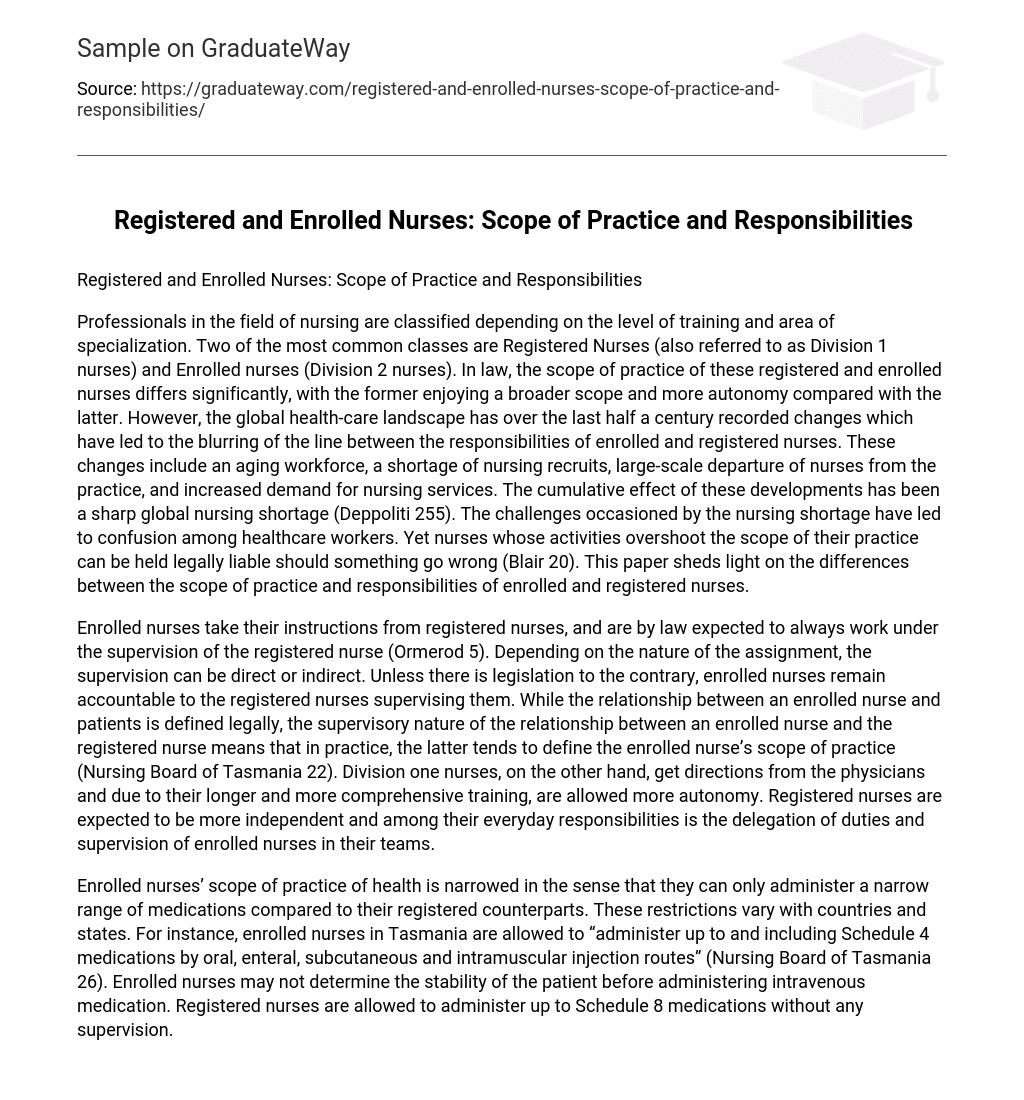Professionals in the field of nursing are classified depending on the level of training and area of specialization. Two of the most common classes are Registered Nurses (also referred to as Division 1 nurses) and Enrolled nurses (Division 2 nurses). In law, the scope of practice of these registered and enrolled nurses differs significantly, with the former enjoying a broader scope and more autonomy compared with the latter. However, the global health-care landscape has over the last half a century recorded changes which have led to the blurring of the line between the responsibilities of enrolled and registered nurses. These changes include an aging workforce, a shortage of nursing recruits, large-scale departure of nurses from the practice, and increased demand for nursing services. The cumulative effect of these developments has been a sharp global nursing shortage (Deppoliti 255). The challenges occasioned by the nursing shortage have led to confusion among healthcare workers. Yet nurses whose activities overshoot the scope of their practice can be held legally liable should something go wrong (Blair 20). This paper sheds light on the differences between the scope of practice and responsibilities of enrolled and registered nurses.
Enrolled nurses take their instructions from registered nurses, and are by law expected to always work under the supervision of the registered nurse (Ormerod 5). Depending on the nature of the assignment, the supervision can be direct or indirect. Unless there is legislation to the contrary, enrolled nurses remain accountable to the registered nurses supervising them. While the relationship between an enrolled nurse and patients is defined legally, the supervisory nature of the relationship between an enrolled nurse and the registered nurse means that in practice, the latter tends to define the enrolled nurse’s scope of practice (Nursing Board of Tasmania 22). Division one nurses, on the other hand, get directions from the physicians and due to their longer and more comprehensive training, are allowed more autonomy. Registered nurses are expected to be more independent and among their everyday responsibilities is the delegation of duties and supervision of enrolled nurses in their teams.
Enrolled nurses’ scope of practice of health is narrowed in the sense that they can only administer a narrow range of medications compared to their registered counterparts. These restrictions vary with countries and states. For instance, enrolled nurses in Tasmania are allowed to “administer up to and including Schedule 4 medications by oral, enteral, subcutaneous and intramuscular injection routes” (Nursing Board of Tasmania 26). Enrolled nurses may not determine the stability of the patient before administering intravenous medication. Registered nurses are allowed to administer up to Schedule 8 medications without any supervision. It is the responsibility of the registered nurses to determine the stability of patients before administering intravenous medications or delegating the duty to enrolled nurses.
Although enrolled nurses are an important resource in health care, their scope of practice and their responsibilities are limited and are dynamic depending on the registered nurses in whose teams enrolled nurses are assigned. The important idea is that most states require that enrolled nurses work under the supervision of registered nurses, largely because the former are not trained in some important issues such as intravenous management.
Works Cited
Australian Nursing Foundation. Nursing Education: Enrolled Nurse. Retrieved May 21, 2010,
from http://www.anf.org.au/pdf/policies/P_Nursing_education_EN.pdf
Blair, P. Determine Your Scope of Practice. Nursing Management, April 2003; 34(4): pp 20-21.
Deppoliti, D. Exploring How New Registered Nurses Construct Professional Identity in Hospital
Settings. The Journal of Continuing Education in Nursing, June 2008, Vol. 39, No. 6: pp 255-264.
Nursing Board of Tasmania. Final Report: Examination of the Role and Scope of the Enrolled
Nurse in Tasmania. 2005. Tasmania.
Ormerod, M. National Review of Nursing Education, 2001. Victoria: National Enrolled Nurse
Association.





